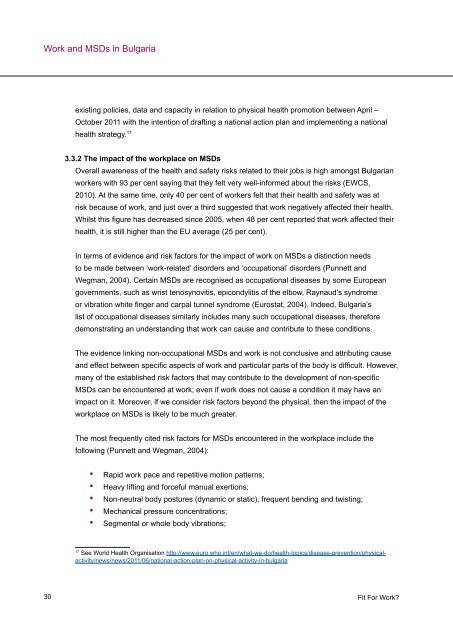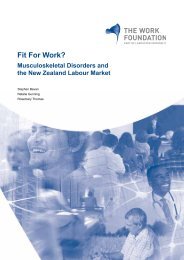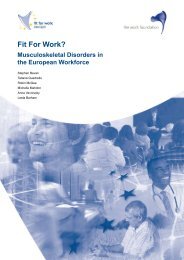FfW Bulgarian report (English language) - Fit for Work Europe
FfW Bulgarian report (English language) - Fit for Work Europe
FfW Bulgarian report (English language) - Fit for Work Europe
You also want an ePaper? Increase the reach of your titles
YUMPU automatically turns print PDFs into web optimized ePapers that Google loves.
<strong>Work</strong> and MSDs in Bulgaria<br />
30<br />
existing policies, data and capacity in relation to physical health promotion between April –<br />
October 2011 with the intention of drafting a national action plan and implementing a national<br />
health strategy. 17<br />
3.3.2 The impact of the workplace on MSDs<br />
Overall awareness of the health and safety risks related to their jobs is high amongst <strong>Bulgarian</strong><br />
workers with 93 per cent saying that they felt very well-in<strong>for</strong>med about the risks (EWCS,<br />
2010). At the same time, only 40 per cent of workers felt that their health and safety was at<br />
risk because of work, and just over a third suggested that work negatively affected their health.<br />
Whilst this figure has decreased since 2005, when 48 per cent <strong>report</strong>ed that work affected their<br />
health, it is still higher than the EU average (25 per cent).<br />
In terms of evidence and risk factors <strong>for</strong> the impact of work on MSDs a distinction needs<br />
to be made between ‘work-related’ disorders and ‘occupational’ disorders (Punnett and<br />
Wegman, 2004). Certain MSDs are recognised as occupational diseases by some <strong>Europe</strong>an<br />
governments, such as wrist tenosynovitis, epicondylitis of the elbow, Raynaud’s syndrome<br />
or vibration white finger and carpal tunnel syndrome (Eurostat, 2004). Indeed, Bulgaria’s<br />
list of occupational diseases similarly includes many such occupational diseases, there<strong>for</strong>e<br />
demonstrating an understanding that work can cause and contribute to these conditions.<br />
The evidence linking non-occupational MSDs and work is not conclusive and attributing cause<br />
and effect between specific aspects of work and particular parts of the body is difficult. However,<br />
many of the established risk factors that may contribute to the development of non-specific<br />
MSDs can be encountered at work; even if work does not cause a condition it may have an<br />
impact on it. Moreover, if we consider risk factors beyond the physical, then the impact of the<br />
workplace on MSDs is likely to be much greater.<br />
The most frequently cited risk factors <strong>for</strong> MSDs encountered in the workplace include the<br />
following (Punnett and Wegman, 2004):<br />
• Rapid work pace and repetitive motion patterns;<br />
• Heavy lifting and <strong>for</strong>ceful manual exertions;<br />
• Non-neutral body postures (dynamic or static), frequent bending and twisting;<br />
• Mechanical pressure concentrations;<br />
• Segmental or whole body vibrations;<br />
17 See World Health Organisation http://www.euro.who.int/en/what-we-do/health-topics/disease-prevention/physicalactivity/news/news/2011/06/national-action-plan-on-physical-activity-in-bulgaria<br />
<strong>Fit</strong> For <strong>Work</strong>?







